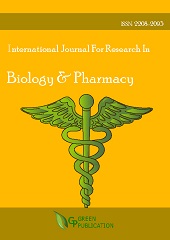Influence of Hemolysis on the Analytical Performance of BS 300 in the Determination of 6 Enzymes
DOI:
https://doi.org/10.53555/bp.v6i2.1192Keywords:
biochemistry, BS 300, enzymes, hemolysis, interferenceAbstract
Hemolysis is a common source of error in the determination of a large number of biochemical blood parameters. The aim of this study is to determine the hemolysis influence on analytical performances of the BS 300 (Mindray®) on the dosage of 6 enzymes such as lipase, gammaglutamyl transferase, alkaline phosphatase, alanine transaminase, aspartate aminotransferase and lactate dehydrogenase.The secondary aim was to establish a reliable reporting for the clinicians in front of hemolysed samples for the enzymes dosage. To determine an influence of the hemolysis on the measure, the variation limit of 10 % was chosen. Gammaglutamyl transferase, and lipase were negatively influenced by the hemolysis. Alanine transaminase, aspartate aminotransferase and lactate dehydrogenase were positively influenced by the hemolysis.
Downloads
References
Benchekroun L. et al. 2007. Interférence de l’hémolyse sur la détermination des paramètres de biochimie clinique. Maroc Médical, tome 29 n°4
Vassault A, Azzedine MC, Bailly M, Cam G, Dumont G et al. Dictionnaire des termes à l’usage de la validation de techniques. Ann biol clin 1986 ;44 :679 - 85.
Kroll MH, Elin RJ. Interference with clinical laboratory analyses. Clin Chem. 1994 ;40(11 Pt1):1996–2005.
Damien A. Interférence de l’hémolyse, sur le dosage des principaux paramètres biochimiques [Thèse]. Pharmacie :Angers ;2015. 106p.
Damien A, Sacchetto E, Dumontet E, Le Carrer D, Orsonneau JL et al. Hemolysis influence on twenty-two biochemical parameters measurement. Ann Biol Clin 2014 ;72 (3) : 297-311.
Persijn P, Van der Slik W. A New Method for the Determination of γ-Glutamyltransferase in Serum. Chem Clin Biochem. 1999;14: 421-27
Soupart, P. In: Amino Acid Pools (Holden, J. T., ed.) Elsevier, Amsterdam, pp. 220—262
Ben Mohammed S, Ben amor A, Najjar M F. Etude de l’interférence de l’hémolyse sur la détermination de 22 paramètres biochimiques courants. Eurobiologiste 2003; 263: 13 – 22.
Lippi G, Salvagno G.L ,Blanckaert M . Multicenter evaluation of the hemolysis index in automated
clinical chemistry systems. Clin Chem Lab Med 2009;47(8):934–39.
Lippi G, Salvagno LG, Montagnana M, Brocco G, Guidi GC. Influence of hemolysis on routine clinical chemistry testing. Clin Chem Lab Med 2006 ;44:311-6.
Plebani M, Carraro P. Mistakes in a stat laboratory: types and frequency. Clin Chem 1997; 43:1348-51.
Carraro P, Servidio P, Plebani M. Haemolyzed specimens: a reason for rejection or clinical challenge? Clin Chem 2000;46:306-7.
Hinckley C. Defining the best quality-control systems by design and inspection. Clin Chem 1997; 43:873-9.
Glick M, Ryder K, Jackson S. Graphical comparisons of interferences in clinical chemistry instrumentation. Clin Chem 1986;32:470-5.
Thomas L. Haemolysis as influence and interference factor. eJIFCC 2010; vol 13 no 4: Available at: http://www.ifcc.org/ejifcc/vol13no4/130401002.htm.
Fairbanks VF, Klee GG. Biochemical aspects of hematology. In: Burtis CA, Ashwood ER, eds. Tietz Textbook of Clinical Chemistry. 3rd ed. Philadelphia: WB Saunders Company; 1999. p.1673-6.
Clinical Laboratory Improvements Amendments of 1988. Final Rule. Laboratory Requirements. Federal Register 1992;57:7002-288.
Sonntag O. Haemolysis as an interference factor in clinical chemistry. J Clin Chem Clin Biochem 1986;24:127-39.
Yucel D, Dalva C. Effect of in vitro hemolysis on 25 common biochemical tests. Clin Chem 1992;38:575-7.
Scott MG, Heusel JW, Le Grys VA, Siggaard AO. In: Burtis CA, Ashwood ER, eds. Tietz Textbook of Clinical Chemistry. 4th ed. Philadelphia: WB Saunders Company; 2006.p.1058-60.
Randall AG, Garcia-Webb P, Beilby JB. Interference by haemolysis, icterus and lipaemia in assays on the Beckman Synchron CX5 and methods for correction. Ann Clin Biochem 1990;27:345-52
Bonini P, Plebani M, Ceriotti F, Rubboli F. Errors in laboratory medicine. Clin Chem 2002;48:691-8.
Plebani M. Laboratory errors: How to improve pre-and post-analytical phases? Biochem Med 2007;17:5-9.
Jun Zou Debra K.Estimating the effects of hemolysis on potassium and LDH laboratory results Clinica Chimica Acta 421 (2013) 60–61
Downloads
Published
How to Cite
Issue
Section
License
Copyright (c) 2020 International Journal For Research In Biology & Pharmacy (ISSN: 2208-2093)

This work is licensed under a Creative Commons Attribution-NonCommercial-NoDerivatives 4.0 International License.
In consideration of the journal, Green Publication taking action in reviewing and editing our manuscript, the authors undersigned hereby transfer, assign, or otherwise convey all copyright ownership to the Editorial Office of the Green Publication in the event that such work is published in the journal. Such conveyance covers any product that may derive from the published journal, whether print or electronic. Green Publication shall have the right to register copyright to the Article in its name as claimant, whether separately
or as part of the journal issue or other medium in which the Article is included.
By signing this Agreement, the author(s), and in the case of a Work Made For Hire, the employer, jointly and severally represent and warrant that the Article is original with the author(s) and does not infringe any copyright or violate any other right of any third parties, and that the Article has not been published elsewhere, and is not being considered for publication elsewhere in any form, except as provided herein. Each author’s signature should appear below. The signing author(s) (and, in




